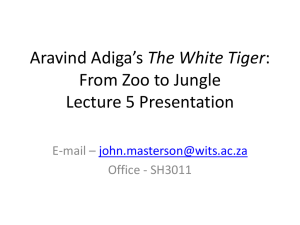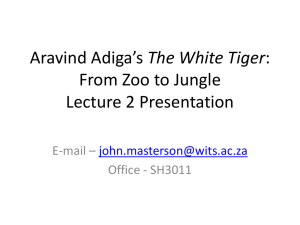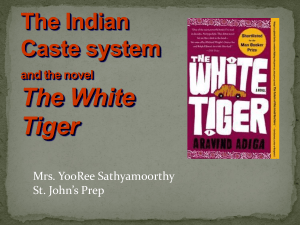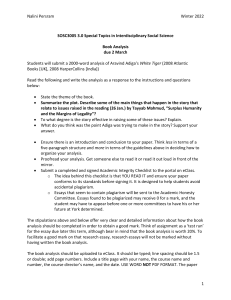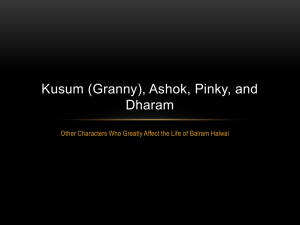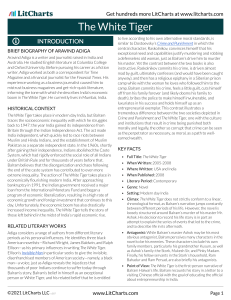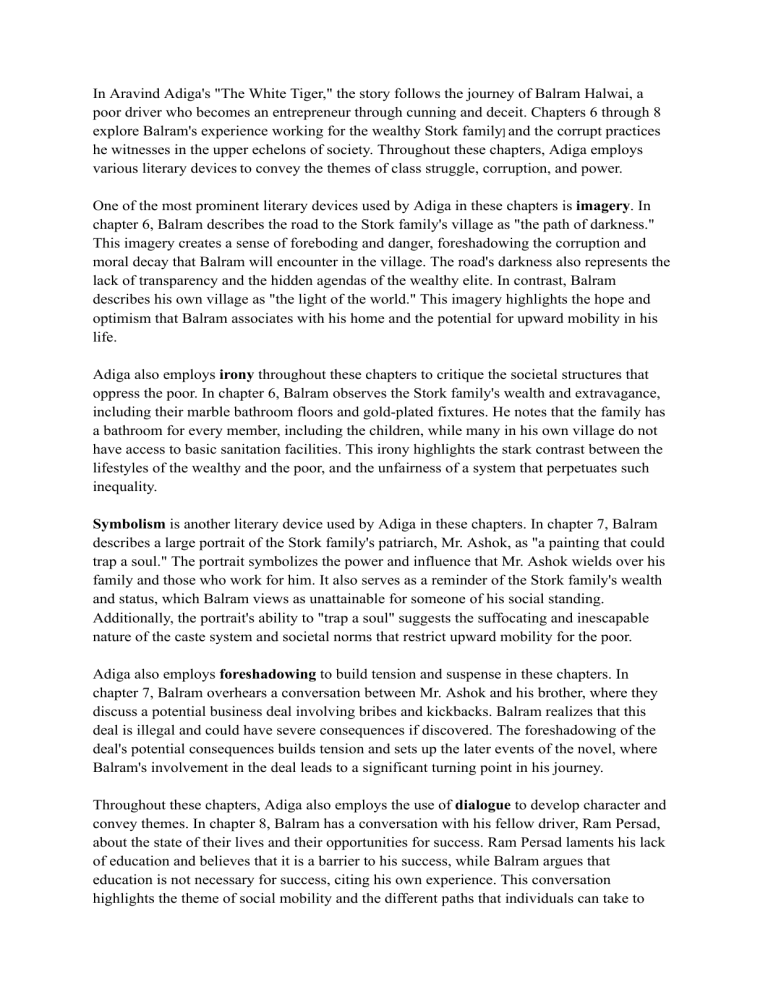
In Aravind Adiga's "The White Tiger," the story follows the journey of Balram Halwai, a poor driver who becomes an entrepreneur through cunning and deceit. Chapters 6 through 8 explore Balram's experience working for the wealthy Stork family] and the corrupt practices he witnesses in the upper echelons of society. Throughout these chapters, Adiga employs various literary devices to convey the themes of class struggle, corruption, and power. One of the most prominent literary devices used by Adiga in these chapters is imagery. In chapter 6, Balram describes the road to the Stork family's village as "the path of darkness." This imagery creates a sense of foreboding and danger, foreshadowing the corruption and moral decay that Balram will encounter in the village. The road's darkness also represents the lack of transparency and the hidden agendas of the wealthy elite. In contrast, Balram describes his own village as "the light of the world." This imagery highlights the hope and optimism that Balram associates with his home and the potential for upward mobility in his life. Adiga also employs irony throughout these chapters to critique the societal structures that oppress the poor. In chapter 6, Balram observes the Stork family's wealth and extravagance, including their marble bathroom floors and gold-plated fixtures. He notes that the family has a bathroom for every member, including the children, while many in his own village do not have access to basic sanitation facilities. This irony highlights the stark contrast between the lifestyles of the wealthy and the poor, and the unfairness of a system that perpetuates such inequality. Symbolism is another literary device used by Adiga in these chapters. In chapter 7, Balram describes a large portrait of the Stork family's patriarch, Mr. Ashok, as "a painting that could trap a soul." The portrait symbolizes the power and influence that Mr. Ashok wields over his family and those who work for him. It also serves as a reminder of the Stork family's wealth and status, which Balram views as unattainable for someone of his social standing. Additionally, the portrait's ability to "trap a soul" suggests the suffocating and inescapable nature of the caste system and societal norms that restrict upward mobility for the poor. Adiga also employs foreshadowing to build tension and suspense in these chapters. In chapter 7, Balram overhears a conversation between Mr. Ashok and his brother, where they discuss a potential business deal involving bribes and kickbacks. Balram realizes that this deal is illegal and could have severe consequences if discovered. The foreshadowing of the deal's potential consequences builds tension and sets up the later events of the novel, where Balram's involvement in the deal leads to a significant turning point in his journey. Throughout these chapters, Adiga also employs the use of dialogue to develop character and convey themes. In chapter 8, Balram has a conversation with his fellow driver, Ram Persad, about the state of their lives and their opportunities for success. Ram Persad laments his lack of education and believes that it is a barrier to his success, while Balram argues that education is not necessary for success, citing his own experience. This conversation highlights the theme of social mobility and the different paths that individuals can take to achieve success, as well as the importance of self-determination and agency in creating one's own destiny. Adiga also employs the use of irony and satire to critique the corrupt practices of the wealthy elite. In chapter 8, Balram attends a wedding in the Stork family's village and witnesses the excessive wealth and extravagance on display. He notes the wastefulness of the food and decorations, as well as the entitlement of the guests, who seem to view the wedding as a way to flaunt their wealth and status. Adiga uses this scene to satirize the excesses of the upper class and their lack of concern for the poverty and suffering of the lower classes. The scene also highlights the way in which the wealthy elite use their power and influence to maintain their position of privilege and perpetuate the inequalities of the caste system. In conclusion, chapters 6 through 8 of "The White Tiger" use a variety of literary devices to convey the themes of class struggle, corruption, and power. Adiga employs imagery, irony, symbolism, foreshadowing, dialogue, and satire to develop the plot and characters, as well as to critique the societal structures that oppress the poor. Through these literary devices, Adiga creates a vivid and engaging narrative that challenges readers to question the morality of a system that allows such stark inequality to exist. The novel's exploration of these themes and its use of literary devices make it a powerful critique of Indian society and a compelling commentary on the nature of power and corruption.
